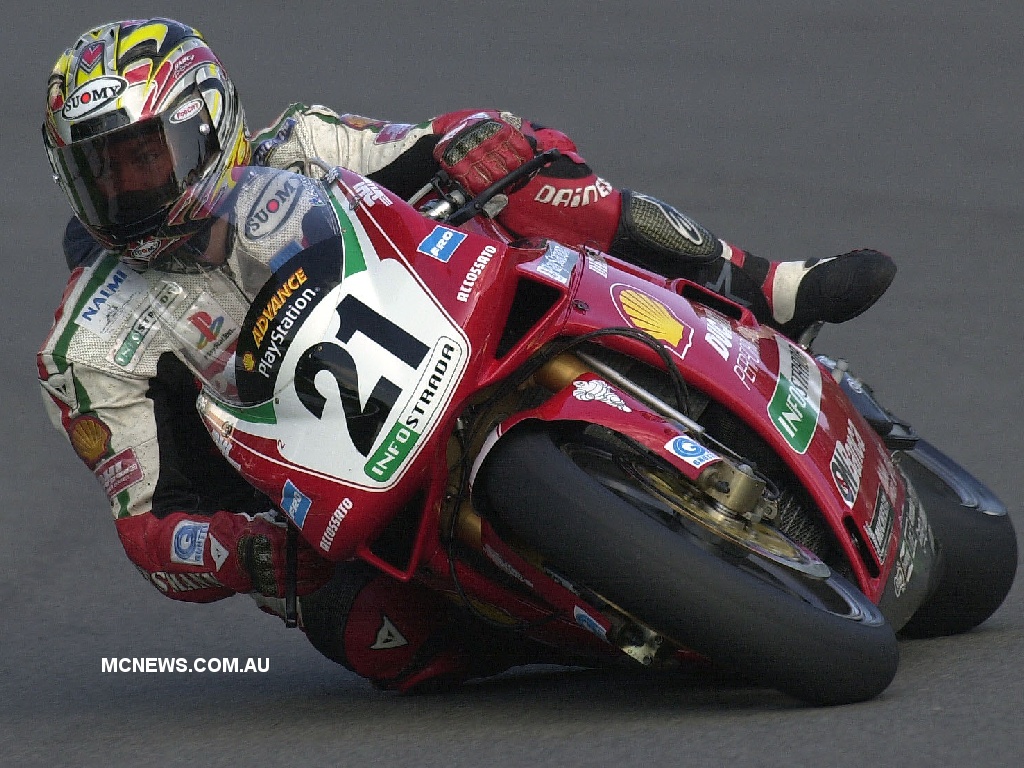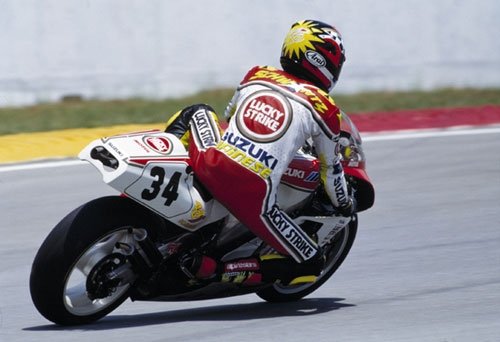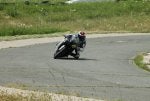In an attempt to keep from mangling the track pics thread any further I thought I would start a place where people who are looking for critique on their riding style, body position, condom size...whatever.
One of the great things about this forum is that there are more than a few exceptionally skilled teachers and I am hoping they will consider offering their advice here as well.
THE THREE GOLDEN RULES OF BODY POSITIONING
1) The rider should have uninhibited access to the controls at all times
2) The rider should be in a comfortable position which interferes the least with the motorcycle.
3) The rider should put himself/herself into a position which free's up traction when it is needed most.
A quick breakdown of the above:
1) The rider should have uninhibited access to the controls at all times - This simply means that your body position needs to allow you to be able to work all of the controls.
I often see people leaning far off to the left in an effort to be Marquez-esque however their right arm is fully straight with no bend in it. What happens if you hit a bump and get a wobble? Suddenly that bar has a ~180lb rider attached to it that it has to move and bad things happen. You always need to be free and loose on the controls, and your body position should support this, not hinder it.
2) The rider should be in a comfortable position which interferes the least with the motorcycle. - This is really two parts but "4 golden rules" sounds dumb, so work with me here :devious
Comfort - Your BP should be comfortable. I am not talking couch-like, but it should not put a strain on you just to maintain your body position. It should feel natural and require no thought to maintain. If you have doubts whether or not your BP is comfortable enough, run 20 laps at your favorite track and tell me how you feel
Interfere the least - Basically this means that your weight needs to be distributed in such a way that it does not impact what the motorcycle is trying to do. For me, that usually means 75% of my weight is on the pegs, and 25% on the seat. Those numbers change as the track demands but overall, those are some good numbers. (5% legs, 95% seat on long straights or 95% legs, 5% seat over really bumpy sections).
Note that nowhere on this list are hands/wrists. It should be the goal of every rider to keep weight off of their hands/wrists if at all possible. There are of course exceptions to this rule...heavy braking for instance. It is virtually impossible to keep weight off of your hands under heavy braking, but by definition, if you are braking hard, you are straight up and down and so we do not really need to be light on the bars when straight. Still, we want to keep as much weight as possible off the bars.
3) The rider should put himself/herself into a position which free's up traction when it is needed most. - This gets a little more complex.
Your front tire has 100% traction that needs to be divided up between cornering, braking forces, and bar input.
If you are going straight and need to stop, you can devote 100% of that traction to braking and be fine, right?
Trail braking is when you are cornering and applying the brakes at the same time. If you are braking with 20% of your available traction, then you theoretically have 80% left to corner with, right? I say 'theoretically' because there is no such thing as having zero bar input. There is always some.
Some schools call it "steering input", "light pressure", or at Penguin we call it "thumb and forefinger" pressure. In the above example it would ideally be something more like 20% braking, 78% cornering, 2% bar input. That 2% is necessary to keep the bike carving through the turn.
Here is a quick example of why this is so critical:
Rider 1 enters a turn. He is skilled and has excellent body position. As he approaches the turn he trail brakes as he begins to lean the bike. 30% brakes/ 68% cornering/ 2% bar, then 20/78/2, 10/88/2, and finally at the apex he releases his brakes entirely and is 0/98/2.
Rider 2 says "well shit, he can do it, so can I!". Unfortunately for Rider 2 his body positioning is not as good. Since they are at the same speed, Rider 2 will need to use the same braking and lean angle. Upon entering the turn he hits 30% braking, 68% cornering, except because his BP is not as good he is using 5% on bar pressure. He starts to slide the front end but is likely used to it though as he has to keep up with these guys regularly. At 20/78/5 that slide becomes a lore more pronounced. The more you lean, the more that slide gets closer to the inevitable. At 10/88/5 the drama starts and he is really pushing wide at the apex. In desperation he lets go of the brake but needs to tip the bike in to make the turn at the speed he is at. 0/98/5 is a really polite way of saying that he just lost the front and is crashing.
Same speed, same lean. Rider 1 successfully navigated the turn due to superior BP. Rider 2 is in the med center.
Bar input effectively creates an artificial ceiling of traction, and believe me when I say that 5% is VERY minimal bar input. Most students that I see are in the 20%-30% range.
THAT is why I am faster than some people at my local track. It isn't because I have a faster bike, or because I have bigger balls. It is because when I get to a turn I do all that I can to free up traction by NOT introducing unwanted bar input.
One of the great things about this forum is that there are more than a few exceptionally skilled teachers and I am hoping they will consider offering their advice here as well.
This was posted in another thread but it brings up a great point: There are ALWAYS exceptions to the rules. This is terrible body positioning by the book but clearly, it works. All we can try to do is to get as close as possible to what we know to be right.
THE THREE GOLDEN RULES OF BODY POSITIONING
1) The rider should have uninhibited access to the controls at all times
2) The rider should be in a comfortable position which interferes the least with the motorcycle.
3) The rider should put himself/herself into a position which free's up traction when it is needed most.
A quick breakdown of the above:
1) The rider should have uninhibited access to the controls at all times - This simply means that your body position needs to allow you to be able to work all of the controls.
I often see people leaning far off to the left in an effort to be Marquez-esque however their right arm is fully straight with no bend in it. What happens if you hit a bump and get a wobble? Suddenly that bar has a ~180lb rider attached to it that it has to move and bad things happen. You always need to be free and loose on the controls, and your body position should support this, not hinder it.
2) The rider should be in a comfortable position which interferes the least with the motorcycle. - This is really two parts but "4 golden rules" sounds dumb, so work with me here :devious
Comfort - Your BP should be comfortable. I am not talking couch-like, but it should not put a strain on you just to maintain your body position. It should feel natural and require no thought to maintain. If you have doubts whether or not your BP is comfortable enough, run 20 laps at your favorite track and tell me how you feel
Interfere the least - Basically this means that your weight needs to be distributed in such a way that it does not impact what the motorcycle is trying to do. For me, that usually means 75% of my weight is on the pegs, and 25% on the seat. Those numbers change as the track demands but overall, those are some good numbers. (5% legs, 95% seat on long straights or 95% legs, 5% seat over really bumpy sections).
Note that nowhere on this list are hands/wrists. It should be the goal of every rider to keep weight off of their hands/wrists if at all possible. There are of course exceptions to this rule...heavy braking for instance. It is virtually impossible to keep weight off of your hands under heavy braking, but by definition, if you are braking hard, you are straight up and down and so we do not really need to be light on the bars when straight. Still, we want to keep as much weight as possible off the bars.
3) The rider should put himself/herself into a position which free's up traction when it is needed most. - This gets a little more complex.
Your front tire has 100% traction that needs to be divided up between cornering, braking forces, and bar input.
If you are going straight and need to stop, you can devote 100% of that traction to braking and be fine, right?
Trail braking is when you are cornering and applying the brakes at the same time. If you are braking with 20% of your available traction, then you theoretically have 80% left to corner with, right? I say 'theoretically' because there is no such thing as having zero bar input. There is always some.
Some schools call it "steering input", "light pressure", or at Penguin we call it "thumb and forefinger" pressure. In the above example it would ideally be something more like 20% braking, 78% cornering, 2% bar input. That 2% is necessary to keep the bike carving through the turn.
Here is a quick example of why this is so critical:
Rider 1 enters a turn. He is skilled and has excellent body position. As he approaches the turn he trail brakes as he begins to lean the bike. 30% brakes/ 68% cornering/ 2% bar, then 20/78/2, 10/88/2, and finally at the apex he releases his brakes entirely and is 0/98/2.
Rider 2 says "well shit, he can do it, so can I!". Unfortunately for Rider 2 his body positioning is not as good. Since they are at the same speed, Rider 2 will need to use the same braking and lean angle. Upon entering the turn he hits 30% braking, 68% cornering, except because his BP is not as good he is using 5% on bar pressure. He starts to slide the front end but is likely used to it though as he has to keep up with these guys regularly. At 20/78/5 that slide becomes a lore more pronounced. The more you lean, the more that slide gets closer to the inevitable. At 10/88/5 the drama starts and he is really pushing wide at the apex. In desperation he lets go of the brake but needs to tip the bike in to make the turn at the speed he is at. 0/98/5 is a really polite way of saying that he just lost the front and is crashing.
Same speed, same lean. Rider 1 successfully navigated the turn due to superior BP. Rider 2 is in the med center.
Bar input effectively creates an artificial ceiling of traction, and believe me when I say that 5% is VERY minimal bar input. Most students that I see are in the 20%-30% range.
THAT is why I am faster than some people at my local track. It isn't because I have a faster bike, or because I have bigger balls. It is because when I get to a turn I do all that I can to free up traction by NOT introducing unwanted bar input.



















